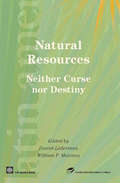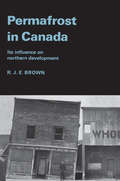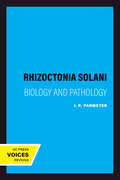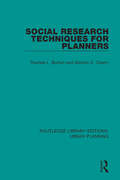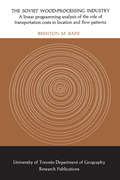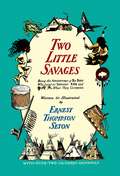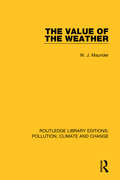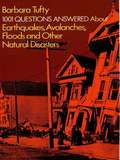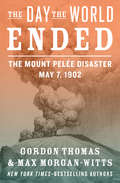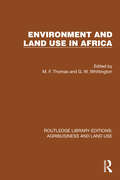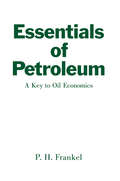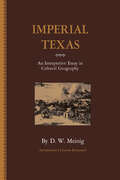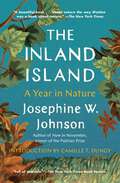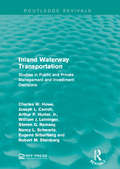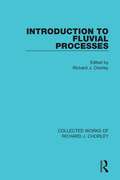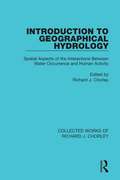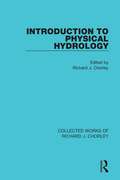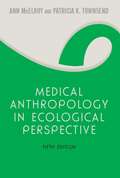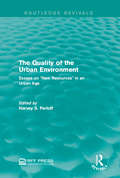- Table View
- List View
Natural Resources: Neither Curse nor Destiny
by William F. Maloney Daniel Lederman'Natural Resources: Neither Course nor Destiny' brings together a variety of analytical perspectives, ranging from econometric analyses of economic growth to historical studies of successful development experiences in countries with abundant natural resources. The evidence suggests that natural resources are neither a curse nor destiny. Natural resources can actually spur economic development when combined with the accumulation of knowledge for economic innovation. Furthermore, natural resource abundance need not be the only determinant of the structure of trade in developing countries. In fact, the accumulation of knowledge, infrastructure, and the quality of governance all seem to determine not only what countries produce and export, but also how firms and workers produce any good.
Permafrost in Canada
by Roger J.E. BrownPermafrost is the thermal condition of the earth's crust when its temperature has been below 32°F continuously for a number of years. Half of Canada's land surface lies in the permafrost region--either in the continuous zone where the ground is frozen to a depth of hundreds of feet, or in the discontinuous zone where permafrost is thinner, and there are areas of unfrozen ground.The existence of permafrost causes problems for the development of the northern regions of all countries extending into the Arctic. Mining operations are hindered by frozen ore which resists blasting and is difficult to thaw. Agriculture is restricted by the presence of permafrost near the ground surface which limits the soil available for plant growth. Engineering structures are also affected by the low temperatures. Ice layers give soil a rock-like structure with high strength. However heat transmitted by buildings often causes the ice to melt, and the resulting slurry is unable to support the structure. Many settlements in northern Canada have examples of structural damage or failure caused by permafrost. In the construction and maintenance of railways, buildings, water and sewage lines, dams, roads, bridges, and airfields, normal techniques must often be modified at additional cost because of permafrost.For the last twenty-five years scientific investigations and engineering projects have increased steadily in Canada's permafrost region, and it is now technically possible to build any structure or conduct any activity on the worst soils and under permafrost conditions.This comprehensive analysis of permafrost--its origin, definition, and occurrence, and the effect it has on industry and agriculture--will be invaluable to the growing number of people working in the north and to those interested in its development.
Rhizoctonia Solani: Biology and Pathology
by John R. ParmeterThis title is part of UC Press's Voices Revived program, which commemorates University of California Press’s mission to seek out and cultivate the brightest minds and give them voice, reach, and impact. Drawing on a backlist dating to 1893, Voices Revived makes high-quality, peer-reviewed scholarship accessible once again using print-on-demand technology. This title was originally published in 1970.This title is part of UC Press's Voices Revived program, which commemorates University of California Press’s mission to seek out and cultivate the brightest minds and give them voice, reach, and impact. Drawing on a backlist dating to 1893, Voices Revived</DIV
Social Research Techniques for Planners (Routledge Library Editions: Urban Planning #5)
by Thomas L. Burton Gordon E. CherryOriginally published in 1970 Social Planning Techniques for Town Planners introduces social research methods for town planners. The book places an emphasis on social research within the planning process, and addresses the problem faced by the research worker at successive stages of a research project. It outlines the major conceptual and organizational problems likely to be encountered in any social research for planning, and provides guidelines for tackling these. The book’s focus is on social science research methods and the application of social and economic research to issues of urban and regional planning and administration.
The Soviet Wood-Processing Industry: A Linear Programming Analysis of the Role of Transportation Costs in Location and Flow Patterns
by Brenton M. BarrSystematic study of the geography distribution of the wood-processing industry has received recent Soviet attention, yet the results have been disappointing. Soviet work has been descriptive and lacking in critical analysis of the location problem. In particular, there has been little, if any, attempt to assess the geographic distribution of the industry within the general context of location theory and to evaluate the role played by individual location factors. This monograph is a case study in the application of linear programming techniques to the analysis of transportation patterns within the wood-processing industry. It will add to North American studies not only a knowledge of the location of wood-processing industries but also a better understanding of the factors which have influenced the location of wood-processing in the Soviet Union.(University of Toronto Department of Geography Research Publications No. 4).
Two Little Savages: Being the Adventures of Two Boys Who Lived as Indians and What They Learned
by Ernest Thompson SetonThis is one of the great classics of nature and boyhood by one of America's foremost nature experts. It presents a vast range of woodlore in the most palatable of forms, a genuinely delightful story. It will provide many hours of good reading for any child who likes the out-of-doors, and will teach him or her many interesting facts of nature, as well as a number of practical skills. It will be sure to awaken an interest in the outdoor world in any youngster who has not yet discovered the fascination of nature.The story concerns two farm boys who build a teepee in the woods and persuade the grownups to let them live in it for a month. During that time they learn to prepare their own food, build a fire without matches, use an axe expertly, make a bed out of boughs; they learn how to "smudge" mosquitoes, how to get clear water from a muddy pond, how to build a dam, how to know the stars, how to find their way when they get lost; how to tell the direction of the wind, blaze a trail, distinguish animal tracks, protect themselves from wild animals; how to use Indian signals, make moccasins, bows and arrows, Indian drums and war bonnets; how to know the trees and plants, and how to make dyes from plants and herbs. They learn all about the habits of various birds and animals, how they get their food, who their enemies are and how they protect themselves from them.Most of this information is not generally available in books, and could be gained otherwise only by years of life and experience in suitable surroundings. Yet Mr. Thompson Seton explains it so vividly and fully, with so many clear, marginal illustrations through the book, that the reader will finish "Two Little Savages" with an enviable knowledge of trees, plants, wild-life, woodlore, Indian crafts and arts, and survival information for the wilds. All of this is presented through a lively narrative that has as its heroes two real boys, typically curious about everything in the world around them, eager to outdo each other in every kind of endeavor. The exciting adventures that befall them during their stay in the woods are just the sort of thing that will keep a young reader enthralled and will stimulate his or her imagination at every turn.
The Value of the Weather
by W. J. MaunderOriginally published in 1970, this book brings together the most significant and pertinent associations between man’s economic and social activities, and the variations in the atmospheric environment. Particular emphasis is placed on economic activities and the weather, economic analysis of weather and the benefits and costs of weather knowledge. In addition, some of the sociological, physiological, political, planning and legal aspects of atmospheric resources are discussed.
1001 Questions Answered About: Earthquakes, Avalanches, Floods and Other Natural Disasters
by Barbara TuftyThis highly readable and informative guide answers hundreds of fascinating questions about storms and atmospheric phenomena. In addition to dispelling common misconceptions, it imparts a wealth of solid scientific data about hurricanes, tornadoes, thunderstorms, wind, fog, ice storms, and other events. The text is embellished with 72 drawings and 20 photographs.
The Day the World Ended: The Mount Pelée Disaster: May 7, 1902
by Gordon Thomas Max Morgan-WittsThe true story of a horrifying natural disaster—and the corruption that made it worse—by the New York Times–bestselling authors of Voyage of the Damned. In late April 1902, Mount Pelée, a volcano on the Caribbean island Martinique, began to wake up. It emitted clouds of ash and smoke for two weeks until violently erupting on May 8. Over 30,000 residents of St. Pierre were killed; they burned to death under rivers of hot lava and suffocated under pounds of hot ash. Only three people managed to survive: a prisoner trapped in a dungeon-like jail cell, a man on the outskirts of town, and a young girl found floating unconscious in a boat days later. So how did a town of thousands not heed the warnings of nature and local scientists, instead staying behind to perish in the onslaught of volcanic ash? Why did the newspapers publish articles assuring readers that the volcano was harmless? And why did the authorities refuse to allow the American Consul to contact Washington about the conditions? The answer lies in politics: With an election on the horizon, the political leaders of Martinique ignored the welfare of their people in order to consolidate the votes they needed to win. A gripping and informative book on the disastrous effects of a natural disaster coupled with corruption, The Day the World Ended reveals the story of a city engulfed in flames and the political leaders that chose to kill their people rather than give up their political power.
Environment and Land Use in Africa (Routledge Library Editions: Agribusiness and Land Use #24)
by M. F. Thomas G. W. WhittingtonOriginally published in 1969, the contributors to this volume examine the natural and social environments of selected areas in Africa and study in detail some particular problems and their solutions. Climate, landforms, soils and vegetation are discussed as fundamental aspects of the physical environment. The next section discusses the social and political environment: demography, agricultural systems and the legacies of colonial administration. Case studies in Malawi, Nigeria, Sudan, Eswatini and Kenya are analysed. The book is aimed at students of African studies, geographers and agriculturalists.
Essentials of Petroleum
by Paul H. FrankelPublished in the year 1969, Essentials of Petroleum is a valuable contribution to the field of Geography.
Imperial Texas: An Interpretive Essay in Cultural Geography
by D.W. MeinigImperial Texas examines the development of Texas as a human region, from the simple outline of the Spanish colony to the complex patterns of the modern state. In this study in cultural geography set into a historical framework, D. W. Meinig, professor of geography at Syracuse University, discusses the “various peoples of Texas, who they are, where they came from, where they settled, and how they are proportioned one to another from place to place.”
The Inland Island: A Year in Nature
by Josephine Johnson&“A beautiful book...about nature the way Walden was a book about nature. It should be read by everyone who still retains the capacity to feel anything&” (The New York Times). Stunningly written and fiercely observed, a new edition of a classic work of nature writing about a year on an Ohio farm, by Pulitzer Prize–winning author Josephine Johnson.Originally published in 1969, The Inland Island is Josephine W. Johnson&’s startling and brilliant chronicle of nature and the seasons at her rambling thirty-seven-acre farm in Ohio, which she and her husband reverted to wilderness with the help of a state forester. Over the course of twelve months, she observes the changing landscape with a naturalist&’s precision and a poet&’s evocative language. Readers will marvel at the way she brings to life flashes of beauty, the inexorable cycle of growth and decay, and the creatures who live alongside her, great and small. A forerunner of iconic American women nature writers and a champion of civil rights who marched in Washington against the Vietnam war, Johnson intersperses these &“delicate marvels&” (The New York Times) with profound reflections about racial inequality, urbanization, social justice, and environmental destruction that speak powerfully to our time. Ready to be rediscovered by a new generation, The Inland Island is a vital and relevant meditation on nature and time, capturing the wonder, beauty, hope—and flaws—of our turbulent world.
Inland Waterway Transportation: Studies in Public and Private Management and Investment Decisions (Routledge Revivals)
by Nancy L. Schwartz Charles W. Howe Joseph L. Carroll Arthur P. Hurter, Jr. William J. Leininger Steven G. Ramsey Eugene Silberberg Robert M. SteinbergInland Waterway Transportation explores how tools of economic analysis can improve the efficiency of both public and private investment in inland waterway transportation. Originally published in 1969, this study investigates how waterway transportation has been affected by public operating policy, costs and charges for the use of waterways in the United States as well as the impact of relationships central to waterway policy and individual firms such as the effect of the waterway environment on a firm’s efficiency. This title will be of interest to students of Environmental Studies and professionals.
Introduction to Fluvial Processes (Collected Works of Richard J. Chorley)
by Richard J. ChorleyOriginally published in this form in 1971, the content of this book was originally part of a larger composite volume ‘Water, Earth and Man’ (1969) which provided a synthesis of hydrology, geomorphology and socio-economic geography. This volume brings together the systematic theme of geomorphology while maintaining a link with the original book which emphasised the benefit of the study of water being considered in the widest sense within the physical and social environments.
Introduction to Geographical Hydrology: Spatial Aspects of the Interactions Between Water Occurrence and Human Activity (Collected Works of Richard J. Chorley #Vol. 408)
by Richard J. ChorleyOriginally published in this form in 1971, the content of this book was originally part of a larger composite volume ‘Water, Earth and Man’ (1969) which provided a synthesis of hydrology, geomorphology and socio-economic geography. This volume brings together the systematic theme of spatial aspects of the interactions between water occurrence and human activity.
Introduction to Physical Hydrology (Collected Works of Richard J. Chorley)
by Richard J. ChorleyOriginally published in this form in 1971, the content of this book was originally part of a larger composite volume ‘Water, Earth and Man’ (1969) which provided a synthesis of hydrology, geomorphology and socio-economic geography. This volume brings together the systematic theme of physical hydrology while maintaining a link with the original book which emphasised the benefit of the study of water being considered in the widest sense within the physical and social environments.
Medical Anthropology in Ecological Perspective
by Ann Mcelroy Patricia K TownsendWidespread awareness of emerging infectious diseases and global environmental change makes the ecological perspective of this premier teaching text for medical anthropology as relevant as ever. Integrating biocultural, environmental, and evolutionary approaches to the study of human health, this fifth edition is now thoroughly revised to reflect new developments in the field. Research by human biologists and paleopathologists illuminates the history and prehistory of disease, while the work of cultural and applied anthropologists addresses contemporary health issues. The fifth edition features five new profiles by guest contributors, all leading researchers on health and environment. New topics include community health and disease prevention in urban America; water-borne disease in Ecuador; iodine deficiency in the Himalaya; stress and demographic change in northern Siberia; and participatory action research in Costa Rica. Also included is updated and expanded consideration of refugee health, global aspects of HIV/AIDS, and careers in applied medical anthropology.
Medical Anthropology in Ecological Perspective
by Ann Mcelroy Patricia K TownsendWidespread awareness of emerging infectious diseases and global environmental change makes the ecological perspective of this premier teaching text for medical anthropology as relevant as ever. Integrating biocultural, environmental, and evolutionary approaches to the study of human health, this fifth edition is now thoroughly revised to reflect new developments in the field. Research by human biologists and paleopathologists illuminates the history and prehistory of disease, while the work of cultural and applied anthropologists addresses contemporary health issues. The fifth edition features five new profiles by guest contributors, all leading researchers on health and environment. New topics include community health and disease prevention in urban America; water-borne disease in Ecuador; iodine deficiency in the Himalaya; stress and demographic change in northern Siberia; and participatory action research in Costa Rica. Also included is updated and expanded consideration of refugee health, global aspects of HIV/AIDS, and careers in applied medical anthropology.
The Quality of the Urban Environment: Essays on "New Resources" in an Urban Age (Routledge Revivals)
by Harvey S. PerloffThe quality of the environment in which people live, work, and play influences to no small degree the quality of life itself. The environment can be satisfying and attractive and provide scope for individual development or it can be poisonous, irritating and stunting. The papers in this volume, first published in 1969, are concerned with the urban environment – in which the majority of Americans live – or, more accurately, with the environment of urbanites, for the concern extends to outlying areas where urban dwellers visit and play. The chapters aim to provide a better understanding of the natural resource elements in the urban environment, and will be of interest to students of environmental studies and human geography.
